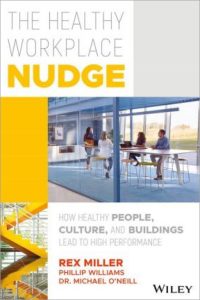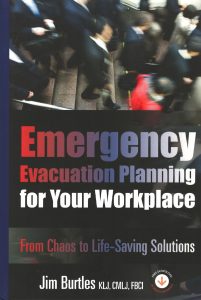Facility officers have a tough job. They must manage people and places and they also must manage problems and find solutions. The two books reviewed here address managing people and finding solutions to difficult facility problems in a logical and defensible way.
THE HEALTHY WORKPLACE NUDGE: HOW HEALTHY PEOPLE, CULTURE, AND BUILDINGS LEAD TO HIGH PERFORMANCE
Rex Miller, Michael O’Neill, and Phillip Williams, Wiley, 2018, 308 pp., hardcover ($32), e-book ($19).
There are many standards for the development of a healthy workplace. While not solely focused on the physical aspects of a healthy building, this text makes heavy use of the International WELL Building Institute’s WELL Building Standard in addition to aspects applicable through the HR department.
 The Healthy Workplace Nudge deals with more than the physical elements of a healthy workplace. Indeed, the book covers little about these physical aspects except for occasional listing of the WELL Standard. Most of the focus centers around redesigning the workplace to achieve healthy physical, social, and personal attitudes. Many of the social and personal recommendations are consistent with APPA’s programs. If a refresher is needed or if getting to APPA U has been elusive, this book may be a satisfactory temporary substitute.
The Healthy Workplace Nudge deals with more than the physical elements of a healthy workplace. Indeed, the book covers little about these physical aspects except for occasional listing of the WELL Standard. Most of the focus centers around redesigning the workplace to achieve healthy physical, social, and personal attitudes. Many of the social and personal recommendations are consistent with APPA’s programs. If a refresher is needed or if getting to APPA U has been elusive, this book may be a satisfactory temporary substitute.
What appear consistently throughout The Healthy Workplace Nudge are recommendations for appropriate behaviors and systems for workers and the financial benefits attributed to changes or improvements in behaviors. These include reduced costs for employee benefits (health insurance plans) and employee productivity. There are examples from noted health care organizations where healthy practices have been implemented, resulting in either zero or reduced health care cost increases, compared to others in the industry that haven’t made such changes.
The reader might ask why “nudge” is included in the title. The nudge in the book refers to compelling an “elephant” (which includes factors that are more or less built-in to human beings, such as our “culture,” “subconscious desires,” “assumptions,” and “fears, biases, and subjective experiences and feelings”) to meet some intended goal. But whether the simile is an elephant or a ship, small changes and encouragement (or “nudges”) take time and persistence before they lead to larger outcomes. As we know, resolutions seldom stick until they have been put in practice for 30 days. Once the desired changes have been made and are endemic within the organization, the savings and benefits resulting from those changes are realized.
The book is nicely organized with summary recommendations for both the organization and individual at the end of each chapter, along with many references if additional research is desired. Use the book to justify or identify changes that will make your organization better and more effective.
EMERGENCY EVACUATION PLANNING FOR YOUR WORKPLACE: FROM CHAOS TO LIFE-SAVING SOLUTIONS
Jim Burtles, Rothstein Publishing, 2013, 340 pp., hardcover ($70), softcover ($67), e-book ($50).
 Talking about emergencies may seem like beating a dead horse right now. Every organization in the world has been compelled to deal with the pandemic in one form or another. In 2001, the terrorist attack on 9/11 was the motivation for Emergency Evacuation Planning for Your Workplace. Now, if it hasn’t been done already, planning for other emergencies is a fundamental and necessary activity for every facility manager.
Talking about emergencies may seem like beating a dead horse right now. Every organization in the world has been compelled to deal with the pandemic in one form or another. In 2001, the terrorist attack on 9/11 was the motivation for Emergency Evacuation Planning for Your Workplace. Now, if it hasn’t been done already, planning for other emergencies is a fundamental and necessary activity for every facility manager.
While the focus of Emergency Evacuation Planning is for the immediate or short-term evacuation of a facility for any reason—external terror attack, internal disaster, earthquake, shooter, etc.—every organization should have a plan (or plans) to deal with an emergency. Frequently, when there is nothing to build on or update, the facility officer is confronted with a blank page and unable to get started. That’s where this book can be extremely helpful. It begins with a big-picture approach; provides assistance with developing a plan; and then discusses important factors to consider, where to find resources, and places to delegate responsibility.
The plan that is developed may apply to other parts of the college or university as well. Consider one senior facility officer’s tale of developing a plan for emergency response where personal protective equipment (PPE) such as N95 masks, gloves, and other items were required. These items were stockpiled and rotated to ensure the stocks remained fresh. When the pandemic hit, the facility organization was prepared, but the affiliated hospital was not—guess where the PPE ended up! Clearly, this was an opportunity to extend the emergency plan beyond the facilities organization.
Experience is a great teacher, but most prefer to learn from a book instead. This book is an excellent teacher. It helps design your plan, identifies points to consider, and advises on who should be aware of the plan so it actually works. If no plan exists, or if the plan is stale and needs refreshing, Emergency Evacuation Planning is a good place to start.
Ted Weidner is professor of engineering practice at Purdue University, West Lafayette, IN, and consults on facilities management issues primarily for educational organizations. He can be reached at [email protected]. If you would like to write a book review, please contact Ted directly.
Bookshelf
Book reviews on current publications relevant to the profession, trends, and working environment of facilities and educational managers and professionals. To contribute a book review, contact Ted Weidner, field editor of this column.
See all Bookshelves.


